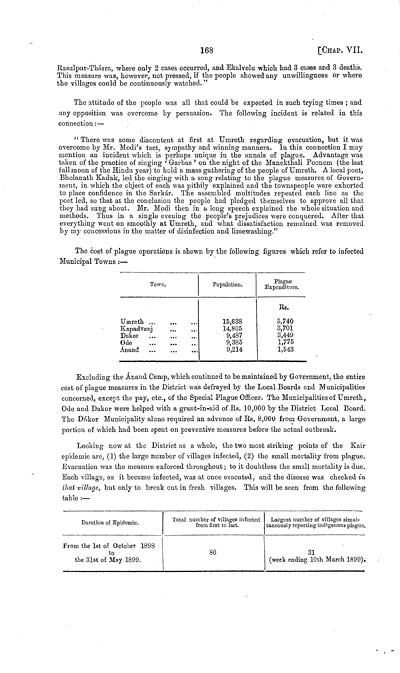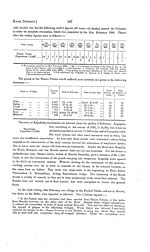Medicine - Disease > Bombay plague: being a history of the progress of plague in the Bombay presidency from September 1896 to June 1899
(236) Page 168
Download files
Individual page:
Thumbnail gallery: Grid view | List view

168 [CHAP. VII.
Rasulpur-Thsra, where only 2 cases occurred, and Ekalvelu which had 3 cases and 3 deaths.
This measure was, however, not pressed, if the people showed any unwillingness or where
the villages could be continuously watched."
The attitude of the people was all that could be expected in such trying times ; and
any opposition was overcome by persuasion. The following incident is related in this
connection : -
"There was some discontent at first at Umreth regarding evacuation, but it was
overcome by Mr. Modi's tact, sympathy and winning manners. In this connection I may
mention an incident which is perhaps unique in the annals of plague. Advantage was
taken of the practice of singing 'Garbas' on the night of the Manekthali Poonem (the last
full moon of the Hindu year) to hold a mass gathering of the people of Umreth. A local poet,
Bholanath Kadak, led the singing with a song relating to the plague measures of Govern-
ment, in which the object of each was pithily explained and the townspeople were exhorted
to place confidence in the Sarkr. The assembled multitudes repeated each line as the
poet led, so that at the conclusion the people had pledged themselves to approve all that
they had sung about. Mr. Modi then in a long speech explained the whole situation and
methods. Thus in a single evening the people's prejudices were conquered. After that
everything went on smoothly at Umreth, and what dissatisfaction remained was removed
by my concessions in the matter of disinfection and limewashing."
The cost of plague operations is shown by the following figures which refer to infected
Municipal Towns :-
Town.
Population.
Plague Expenditure.
Rs.
Umreth
15,638
5,740
Kapadvanj
14,805
3,701
Dakor
9,487
3,449
Ode
9,385
1,775
nand
9,214
1,543
Excluding the nand Camp, which continued to be maintained by Government, the entire
cost of plague measures in the District was defrayed by the Local Boards and Municipalities
concerned, except the pay, etc., of the Special Plague Officer. The Municipalities of Umreth,
Ode and Dakor were helped with a grant-in-aid of Rs.10,000 by the District Local Board.
The Dakor Municipality alone required an advance of Rs.8,000 from Government, a large
portion of which had been spent on preventive measures before the actual outbreak.
Looking now at the District as a whole, the two most striking points of the Kair
epidemic are, (1) the large number of villages infected, (2) the small mortality from plague.
Evacuation was the measure enforced throughout ; to it doubtless the small mortality is due.
Each village, as it became infected, was at once evacuted, and the disease was checked in
that village, but only to break out in fresh villages. This will be seen from the following
table :-
Duration of Epidemic.
Total number of
villages infected
from first to last.
Largest number of
villages simultaneously
reporting indigenous
plague.
From the 1st of October 1898
80
31
to the 31st of May 1899.
(week ending 10th March 1899).
Rasulpur-Thsra, where only 2 cases occurred, and Ekalvelu which had 3 cases and 3 deaths.
This measure was, however, not pressed, if the people showed any unwillingness or where
the villages could be continuously watched."
The attitude of the people was all that could be expected in such trying times ; and
any opposition was overcome by persuasion. The following incident is related in this
connection : -
"There was some discontent at first at Umreth regarding evacuation, but it was
overcome by Mr. Modi's tact, sympathy and winning manners. In this connection I may
mention an incident which is perhaps unique in the annals of plague. Advantage was
taken of the practice of singing 'Garbas' on the night of the Manekthali Poonem (the last
full moon of the Hindu year) to hold a mass gathering of the people of Umreth. A local poet,
Bholanath Kadak, led the singing with a song relating to the plague measures of Govern-
ment, in which the object of each was pithily explained and the townspeople were exhorted
to place confidence in the Sarkr. The assembled multitudes repeated each line as the
poet led, so that at the conclusion the people had pledged themselves to approve all that
they had sung about. Mr. Modi then in a long speech explained the whole situation and
methods. Thus in a single evening the people's prejudices were conquered. After that
everything went on smoothly at Umreth, and what dissatisfaction remained was removed
by my concessions in the matter of disinfection and limewashing."
The cost of plague operations is shown by the following figures which refer to infected
Municipal Towns :-
Town.
Population.
Plague Expenditure.
Rs.
Umreth
15,638
5,740
Kapadvanj
14,805
3,701
Dakor
9,487
3,449
Ode
9,385
1,775
nand
9,214
1,543
Excluding the nand Camp, which continued to be maintained by Government, the entire
cost of plague measures in the District was defrayed by the Local Boards and Municipalities
concerned, except the pay, etc., of the Special Plague Officer. The Municipalities of Umreth,
Ode and Dakor were helped with a grant-in-aid of Rs.10,000 by the District Local Board.
The Dakor Municipality alone required an advance of Rs.8,000 from Government, a large
portion of which had been spent on preventive measures before the actual outbreak.
Looking now at the District as a whole, the two most striking points of the Kair
epidemic are, (1) the large number of villages infected, (2) the small mortality from plague.
Evacuation was the measure enforced throughout ; to it doubtless the small mortality is due.
Each village, as it became infected, was at once evacuted, and the disease was checked in
that village, but only to break out in fresh villages. This will be seen from the following
table :-
Duration of Epidemic.
Total number of
villages infected
from first to last.
Largest number of
villages simultaneously
reporting indigenous
plague.
From the 1st of October 1898
80
31
to the 31st of May 1899.
(week ending 10th March 1899).
Set display mode to: Large image | Zoom image | Transcription
Images and transcriptions on this page, including medium image downloads, may be used under the Creative Commons Attribution 4.0 International Licence unless otherwise stated. ![]()
| India Papers > Medicine - Disease > Bombay plague: being a history of the progress of plague in the Bombay presidency from September 1896 to June 1899 > (236) Page 168 |
|---|
| Permanent URL | https://digital.nls.uk/74586440 |
|---|




